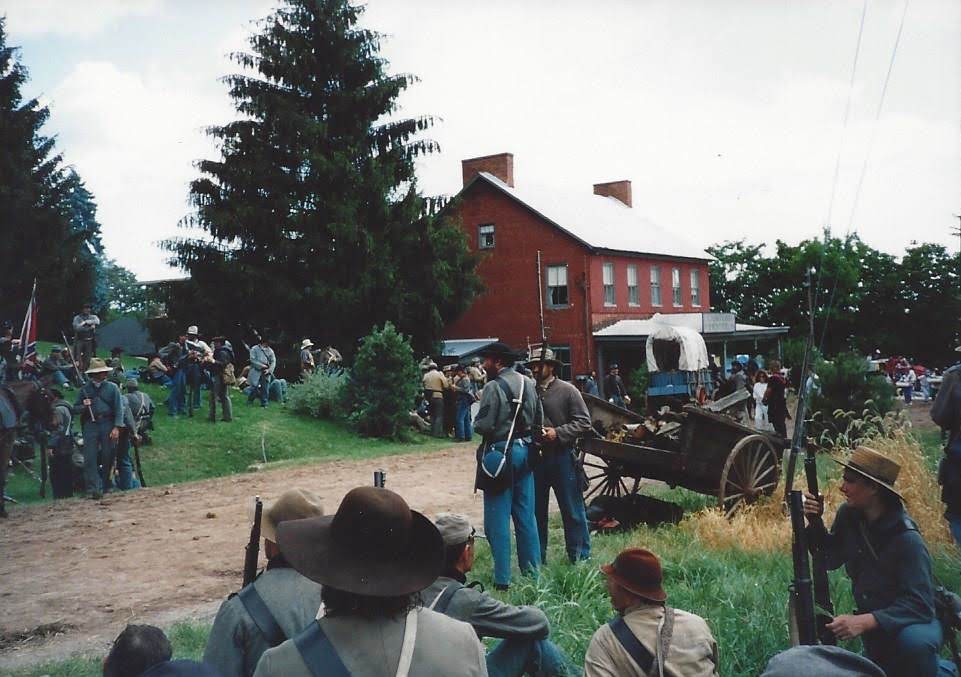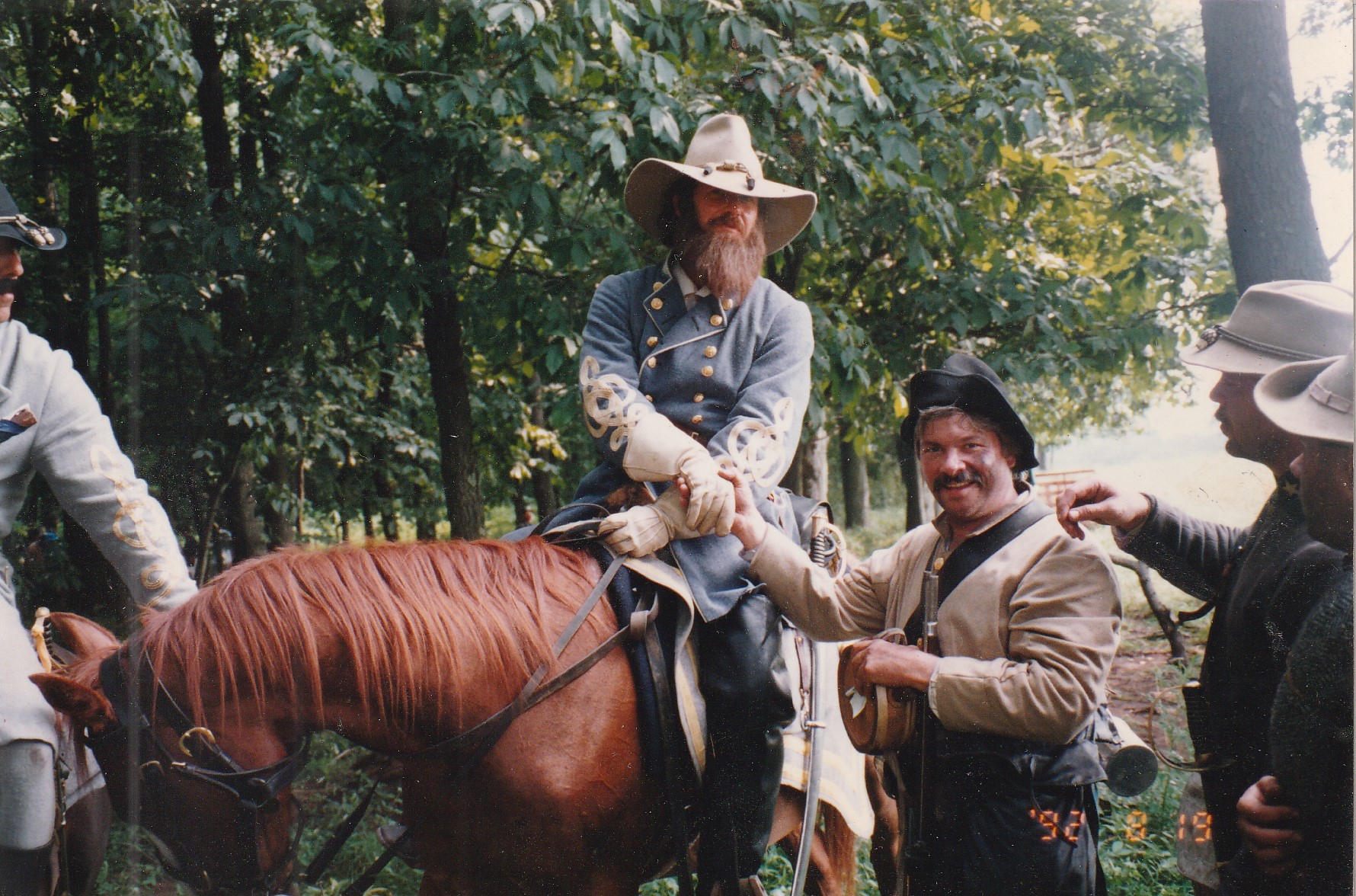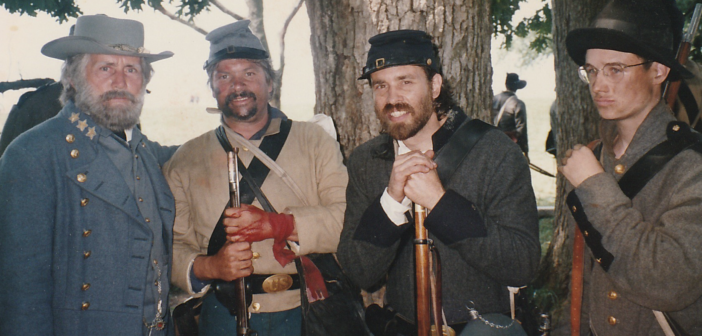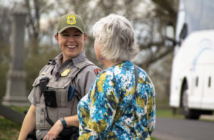The movie Gettysburg Turns 30
By Lisa Gregory
The very first time Ron Maxwell visited the Gettysburg battlefield, he was in good company, indeed.
“I was with Michael Shaara,” he says. Shaara is the author of the Pulitzer Prize-winning book The Killer Angels that depicts the three days of the Battle of Gettysburg. And Maxwell is the director and screenwriter of the movie, Gettysburg, based on that very book.
“We walked the battlefield the way he wrote it, as it exists in the novel,” remembers Maxwell. “We walked it on day one, day two and day three. Needless to say, it was an extraordinary first visit to the battlefield.”
After reading The Killer Angels, Maxwell knew he wanted to bring it to life on screen, and he would return to the very place where it happened to do just that. Now, 30 years later, that movie, Gettysburg, still resonates with many who have watched it countless times and have made pilgrimages to the battlefield because of it.
And, in mid-October, Maxwell and members of the cast will return to Gettysburg for a weekend-long festival to celebrate the anniversary with screenings of the movie and other activities. The festival is in partnership with Maxwell, the Journey Through Hallowed Ground National Heritage Area, the American Battlefield Trust, the Adams County Historical Society, Destination Gettysburg, the Gettysburg Foundation, Gettysburg National Military Park, Main Street Gettysburg and the Seminary Ridge Museum and Education Center, among others.
“People are really passionate about this film,” says Michelle Burrelli, CEO and director of the Journey Through Hallowed Ground National Heritage Area.
Maxwell understands why. “It’s an intimate, personal story,” he says. “The movies that stay with us in our lives—the movies that once we see we can never quite shake them off and we want to see them again— it is because we make a strong emotional connection. I think this is the power of our movie.”
That personal approach was what Shaara intended in writing The Killer Angels as he told the story of the Battle of Gettysburg through its participants such as Gen. Robert E. Lee, Col. Joshua Lawrence Chamberlain, Brig. Gen. John Buford, Lieut. Gen. James Longstreet and Maj. Gen. George E. Pickett.
In the movie these characters are played by actors Martin Sheen, Jeff Daniels, Sam Elliott, Tom Berenger and Stephen Lang, respectively.



“My father was telling the story through the eyes of the characters themselves, the real historical figures, and putting words in their mouths—and nobody really had done that before,” says Jeff Shaara, The New York Times best-selling author of Gods and Generals, the book that followed his father’s
The Killer Angels and was also made into a movie.
The 1993 release of Gettysburg, which received financial backing from media mogul Ted Turner, resulted in a significant increase in visitors to the battlefield. “It changed the way people see this place,” says Garry Adelman, chief historian for the American Battlefield Trust and a longtime licensed battlefield guide. “Before the movie it was mostly an auto tour, where they’d get out in a couple of places, but now people wanted to get out more and explore. Suddenly, the characters were real to them, and they wanted to see where they fought and died.”
In doing so, for many the movie has proven to be a gateway to learning more about the battle and the Civil War itself. “I grew up watching the movie on repeat,” says Andrew Dalton, executive director of the Adams County Historical Society and Gettysburg Beyond the Battle Museum. “It’s a way for people to get interested in the actual history of Gettysburg and a pipeline to researching and understanding the deeper history of Gettysburg.”
“That movie really just cemented my love for American history and Civil War history,” says Christopher Gwinn, chief of interpretation and education at Gettysburg National Military Park. “It inspired me to take it to that next level.”
Sadly, Michael Shaara never saw the movie or even witnessed the making of it. He died in 1988 at the age of 59. But Jeff Shaara says his presence was felt nonetheless.
“A Turner person came up to me and said, ‘Look around you. You do realize what’s going on here? Every bit of this, the crew, the cast, all the equipment, everything that’s going on is a result of your father’s words,’” recalls Jeff Shaara.
Initially, Maxwell considered filming overseas with a rented army. However, while attending a reenactment at Gettysburg during the summer of 1988, he had an idea.
“Suddenly there were thousands of actors,” says Maxwell. “So, everything shifted at that point. I was convinced there was a way to make the movie in the United States, and I wanted to make it at Gettysburg because by that time I had walked the battlefield many, many times, and I knew what a unique topography it was and also that it would be the historical ground.”
In a rare occurrence Maxwell was given permission by the National Park Service to film parts of the movie on the actual battlefield. So Hollywood came to town and locals such as Bill Serfass got to be in a movie.
Although not a reenactor, Serfass did play the part of a soldier. “I was an extra, a background artist,” says Serfass, now a retired music teacher. At the time, young Serfass was married and the father of a newborn. However, “I wanted to experience this,” he recalls. His wife gave her blessing.
That sacrifice did not go unnoticed. During an encounter with Sheen, Serfass shared his story. Sheen provided an autograph for his wife with a note that read, in part, “Thanks for letting Bill join the Confederate Army for ‘Killer Angels.’”
“It was written on a piece of paper torn from a Coke box,” says Serfass with a grin. “That’s all I had.”
Serfass may not have been a reenactor, but many were. “They made the difference in this movie,” says Maxwell of the Union and Confederate reenactors who descended upon Gettysburg and set up camp.
James Lancaster, who played Lieut. Col. Arthur Fremantle, agrees. “You could have probably done without us, but you couldn’t have done without the reenactors,” he says.
“The group of reenactors I worked with were always concerned with authenticity and went to great lengths to ensure that their uniforms, equipment, weapons, drill, etc., were historically accurate for 1863,” says Ted Ballard, a self-described on-set reenactor wrangler and a historian with the Department of the Army at the time. “There were a few who claimed to be wearing reproduction underwear.”’
Some actors even took their cue from the reenactors. “I think we rubbed off on them a bit,” says Will Hutchison, a reenactor and living historian at the time of the filming.
Sam Elliott, for example, needed a more realistic hat. Apparently, he was not happy with the one wardrobe had provided him. “I told him to go to Dirty Billy’s Hats [in Gettysburg]and get yourself a hat,” says King Bennett, a reenactor. “And he did. So that hat you see in the movie, it was made by Dirty Billy’s.”
Other actors embedded themselves within the reenactor camps. “I spent a lot of time riding horseback in the evening with Stephen Lang, smoking cigars and riding from camp to camp,” says Patrick Gorman, who played Maj. Gen. John Bell Hood. “It made us feel right in place.”
As he did so, he remained in character. “I had the saber and the boots and the spurs and the accent I’d chosen to do for Hood,” he says. “I did a lot of research, but I got a lot of stuff that I didn’t get from books about Hood. I thank the reenactors for that.”
Given the place and people participating, some moments during filming seemed to transcend time. “You would be doing a scene and, once you got in the scene, everything seemed to disappear,” says Hutchison. “The cameras disappeared.”
And a man like Lee could come to life.
During the filming of Pickett’s Charge, thousands of reenactors gathered in the heat and humidity. Some were even suffering from heat exhaustion, requiring medical care.
“The crew was running out with Gatorade and water constantly,” says Maxwell.
Maxwell had an idea. “Wouldn’t it be great if we could have Marty Sheen suit up and come out and ride out on Traveller,” he says. “Not that he’s going to be in the shot, but just to boost morale.”
Sheen was not scheduled to work that day. “For him to do that, that’s an hour and a half in makeup—putting the whiskers on and then the costume,” says Maxwell. “He said he would be glad to do it.” Then the magic happened.
“He rides out on Traveller,” says Maxwell. The reenactors began to cheer and chant Lee’s name and converge upon him. “In that moment they were not reenactors, and Martin Sheen wasn’t Martin Sheen, the Hollywood actor,” says Maxwell. “We had 1860s Civil War Confederate soldiers responding to Robert E. Lee. You want to talk about a hair-raising moment.” The scene was not in the script, but Maxwell hurriedly instructed the crew to start filming, capturing the moment for the movie.
Like Lee’s Traveller, horses played a key role in the movie. But not all the actors were natural riders. Take Lancaster, for example. “When the horses arrived, there were lads saying,
‘Oh give me a horse with a bit of spirit,’” he says.
Lancaster was not taking any chances though. “I said, ‘Give me the oldest, half-dead horse you have,” he remembers. His horse seemed calm enough—until it was quitting time. “When he figured out that he was going home, he went into a full gallop,” says Lancaster. “I was holding on for dear life. So I was nearly dead before the cameras even rolled.”
Not all of it was work and surviving wayward horses, though. When the actors and crew were not filming, they made their way into town.
“We hung out at Farnsworth Pub, and I had a gang that was around.
They called us the Irish Brigade,” says Brian Mallon, who played Maj. Gen. Winfield Scott Hancock. “Though most of these friends of mine were playing Confederates. We had a really good time.”
Today, Farnsworth House continues to honor the movie, playing it nonstop amid a collection of memorabilia. “When I’ve gone in there now, it’s like a shrine,” says Mallon.
Much like relics from the battle, memorabilia from the movie can be highly prized. “You can see memorabilia from the movie almost as prolifically as you can memorabilia from the battle,” says Adelman.
Jonathan (Jon Jon) Pinkerton has done his part as a collector, even being contacted by the television series American Pickers. Although he lives in Pittsburgh, his heart is in Gettysburg. Pinkerton says he’s seen the movie a staggering 3,000 times. “My wife can recite lines from the movie, and she has never sat down and watched it,” he says with a chuckle.
Among his impressive and immense collection is Daniels’ original uniform as Chamberlain. And a few Christmases ago, Pinkerton received a very special and unexpected Christmas gift from Lang, who played Pickett. “He gave me his original uniform that he wore in the film,” says Pinkerton. “I think he and the other actors see how much I love this film and how much this stuff means to me, and that it’s not going anywhere.”
In fact, Pinkerton hopes to someday create a museum in Gettysburg displaying his collection.
He is also passing on his love of the movie to his 8-year-old son Lincoln. “His favorite is Pickett,” says Pinkerton. “He loves Stephen Lang.”
Lincoln is proof that the movie continues to serve as a gateway to learning more about Gettysburg, the Civil War and history itself. A legacy that will continue.
“If I had gotten into any other film that year, I would’ve been thrilled, of course, but it would all be dusty and forgotten by now,” says Mallon. “Not Gettysburg.”
Gettysburg The Movie
30th Anniversary Celebration
Gettysburg The Movie
Director’s Cut, Friday, Oct. 13 at 4 p.m.,
Majestic Theater
Gettysburg The Movie
Director’s Cut with Director and Actor Panel Discussion (SOLD OUT)
Saturday, Oct. 14 at 12:30 p.m., Majestic Theater
Copperhead
Director’s Cut with Director Panel Discussion
Sunday, Oct. 15, 1 p.m., Majestic Theater
Gettysburg The Movie Bus Tour (Sold Out)
Friday, Oct. 13 and Oct. 14, noon to 5 p.m.
Beginning at Beyond the Battle Museum
Gettysburg Actor Returns to Make Movie of His Own

Bo Brinkman came to town more than 30 years ago to play Maj. Walter H. Taylor in Gettysburg. “I was living in Los Angeles then,” says the actor. “I had never been in Pennsylvania.”
Once he arrived in Gettysburg, however, he was smitten. “From that moment on I loved the town,” he says.
Now the actor in Gettysburg has become the co-producer, screenwriter and director of a movie again set in the town. But this time it isn’t about the battle. The movie, A Gettysburg Christmas, based on a book by Craig Rupp, tells the story of a woman who has given up on relationships and the holiday before a Christmas miracle helps mend her heart, trust again and realize the importance of family. “It’s a sweet little story,” says Brinkman.
The backdrop is Gettysburg decked out in all its holiday glory; the community was encouraged to keep up Christmas decorations during the making of the movie, which took place in January. “So many people come to Gettysburg because of the history,” says Brinkman. “But what if people came because they wanted to see this neat little town that celebrates Christmas so well and then discover the history?”
Brinkman says he was inspired and encouraged to make the film by local Gettysburg businesswoman Kris Webb, the movie’s co-producer. The two initially met while Brinkman was filming Gettysburg, became friends and are now romantically involved. “Kris was the one that said, ‘We’ve got to make a movie about Gettysburg,” recalls Brinkman. “Gettysburg needs a shot in the arm.’”
A few of the actors in A Gettysburg Christmas include Kelley Jakle, Kate Vernon, Sean Faris, Lee Majors and Bruce Boxleitner. “Most of the cast and crew were friends of mine,” says Brinkman.
The premiere for the independent film will be held at the Majestic Theater on Nov. 27.




